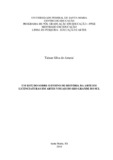| dc.creator | Amaral, Tainan Silva do | |
| dc.date.accessioned | 2019-10-15T13:34:28Z | |
| dc.date.available | 2019-10-15T13:34:28Z | |
| dc.date.issued | 2018-07-30 | |
| dc.identifier.uri | http://repositorio.ufsm.br/handle/1/18593 | |
| dc.description.abstract | Abstract: This dissertation discusses the teaching of art history in graduate degrees in Visual
Arts of the state of Rio Grande do Sul. Such research, which is a located as qualitative
approach methodologically and exploratory, part of interviews with teachers of art history, in
higher education, to raise questions about teaching this discipline. To discuss this teaching,
the goal is to investigate, based on a theoretical framework, the diversity of art stories found
in the interviews with the subjects of research. The relevance of this work revolves around the
need for the study on the teaching of art history. Indicate the possible paths that, currently, are
chosen in the teaching of the discipline referred to above. The research, in the field of
education and art, it is understood as an exploration of the training in art history of art
educators and the historic crossings that influence this educational procress. It can be
concluded that the reports of the teachers interviewed, throughout the text, reflect some
features of the discipline of art history, that in the training of educators. Are these, the
frequent presence of authors such as Ernst Gombrich and Giulio Argan in basic
bibliographies, the use of didatic-methodological procedures such as lectures and dialogued,
seminars, preparation of lesson plans and visits to museums and galeries and, still,
identification on the part of teachers with Cultural Studies and Visual Culture, in addition to
philophical trends and social-cutting theories and critical theory, particularly pos-structuralist
and post-colonialists. It was, finally, that the teachers understand the discipline of art history
as instrumental in basic training of art educators. | eng |
| dc.description.sponsorship | Coordenação de Aperfeiçoamento de Pessoal de Nível Superior - CAPES | por |
| dc.language | por | por |
| dc.publisher | Universidade Federal de Santa Maria | por |
| dc.rights | Attribution-NonCommercial-NoDerivatives 4.0 International | * |
| dc.rights.uri | http://creativecommons.org/licenses/by-nc-nd/4.0/ | * |
| dc.subject | História da arte | por |
| dc.subject | Arte-educador | por |
| dc.subject | Ensino | por |
| dc.subject | History of art | eng |
| dc.subject | Art-educator | eng |
| dc.subject | Teaching | eng |
| dc.title | Um estudo sobre o ensino de História da Arte em licenciaturas em Artes Visuais do Rio Grande do Sul | por |
| dc.title.alternative | A study on the teaching of Art History in graduate degrees in Visual Arts from Rio Grande do Sul | eng |
| dc.type | Dissertação | por |
| dc.description.resumo | Resumo: Esta dissertação discute o ensino de História da Arte em licenciaturas em Artes
Visuais do estado do Rio Grande do Sul. Tal pesquisa, que situa-se metodologicamente como
de abordagem qualitativa e exploratória, parte de entrevistas com professores de História da
Arte, no Ensino Superior, para levantar questões sobre o ensino dessa disciplina. Para discutir
esse ensino, objetiva-se investigar, com base em um referencial teórico, a diversidade de
histórias da arte encontradas nas entrevistas com os sujeitos de pesquisa. A relevância desse
trabalho gira em torno da necessidade do estudo sobre o ensino da História da Arte. Indicamse
os possíveis caminhos que, atualmente, são escolhidos no ensino da disciplina supracitada.
A pesquisa, inserida no campo da Educação e da Arte, entende-se como uma exploração da
formação em História da Arte dos arte-educadores e dos atravessamentos históricos que
influenciam esse processo educativo. Pode-se concluir que os relatos dos professores
entrevistados, ao longo do texto descritos, refletem algumas características da disciplina de
História da Arte, que na formação dos arte-educadores se apresentam. São essas, a presença
frequente de autores como Ernst Gombrich e Giulio Argan nas bibliografias básicas, o uso de
procedimentos didático-metodológicos como aulas expositivo-dialogadas, seminários,
elaboração de planos de aula e visita à museus e galerias e, ainda, identificação por parte dos
professores com os Estudos Culturais e a Cultura Visual, além de tendências filosóficas e
teorias de corte social e da escola crítica, especialmente pós-estruturalistas e pós-colonialistas.
Entendeu-se, por fim, que os professores entrevistados entendem a disciplina de História da
Arte como fundamental na formação básica dos arte-educadores. | por |
| dc.contributor.advisor1 | Pereira, Marcelo de Andrade | |
| dc.contributor.advisor1Lattes | http://lattes.cnpq.br/1518610535671838 | por |
| dc.contributor.referee1 | Victorio Filho, Aldo | |
| dc.contributor.referee1Lattes | http://lattes.cnpq.br/4856601990720597 | por |
| dc.contributor.referee2 | Tomazetti, Elisete Medianeira | |
| dc.contributor.referee2Lattes | http://lattes.cnpq.br/3942924352722374 | por |
| dc.creator.Lattes | http://lattes.cnpq.br/0834240669230618 | por |
| dc.publisher.country | Brasil | por |
| dc.publisher.department | Educação | por |
| dc.publisher.initials | UFSM | por |
| dc.publisher.program | Programa de Pós-Graduação em Educação | por |
| dc.subject.cnpq | CNPQ::CIENCIAS HUMANAS::EDUCACAO | por |
| dc.publisher.unidade | Centro de Educação | por |



